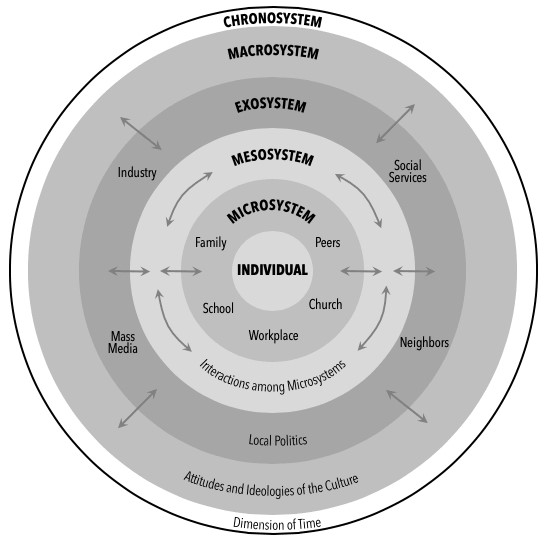5 Ecological Systems Theory
The root of Ecological Systems Theory is attributed to Bronfenbrenner, a Russian-American psychologist, who presented a model in the 1970s for understanding the influence of multiple factors and context on the well-being of a child[1]. Bronfenbrenner argued that these varied and critically influential environments are nested within each other and therefore have profound influences on a child. He did not see this level of analysis in other child development theories, so he developed his own. They explained that a change in one of the environments can have a significant impact on the child, eliminating the sole focus of intervention on just the specific child’s behavior or characteristics. Bronfenbrenner describes influences between many of the system layers are bidirectional, meaning the systems or center (child) is likely just as able to be influenced by the next level of the system as they are to be influential (see diagram)[2]. This insight is enormously helpful in identifying the parts of the system where change efforts should be directed to leverage the influence and therefore maximize impact.
Bronfenbrenner identified 5 different levels of environment and context:
- Microsystem: immediate environment where the child spends much of their time (family, school, daycare, neighborhood, etc.)
- Mesosystem: interactions between the entities in the microsystem (family interactions with school, etc.)
- Exosystem: influential environments on the microsystem (parent’s workplace, school board, etc.)
- Macrosystem: attitude and cultural ideologies (beliefs regarding poverty, racist attitudes, etc.)
- Chronosystem: environmental changes that occur over the lifetime (technological advances, etc.)
This diagram illustrates Bronfenbrenner’s Ecological Systems Theory[3]

Meadows, as referenced in David Peter Stroh’s book, Systems Thinking for Social Change, defines a system as “an interconnected set of elements that are coherently organized in a way that achieves something”. (pg. 16)[4]. This could be a system focused on education, delivering health care, incarcerating and rehabilitating individuals, etc. Systems thinking, Stroh explains, is the “ability to understand these interconnections in order to achieve the desired purpose” (pg. 16). They point out that often a system ends up with outcomes different than what they are intending or even espousing.
When we begin to first understand a community or organizational problem, we need to map out the system in which the problem exists. This provides an understanding of the context and likely influences but doesn’t quite yet tell us how to solve the problem or what the influences mean. To do that, we need to apply systems thinking, which is explained in the next chapter.
- Bronfenbrenner, U. (1977). Toward an experimental ecology of human development. American Psychologist, 32(7), 513–531. https://doi.org/10.1037/0003-066X.32.7.513 ↵
- Guy-Evans, O. (2020, Nov 09). Bronfenbrenner's ecological systems theory. Simply Psychology. www.simplypsychology.org/Bronfenbrenner.html ↵
- Davis, B., & Francis, K. (2023). “Ecological Systems Theory” in Discourses on Learning in Education. https://learningdiscourses.com. ↵
- Stroh, D.P. (2015). Systems thinking for social change: A practical guide to solving complex problems, avoiding unintended consequences, and achieving lasting results. White River Junction, Vermont: Chelsea Green Publishing. ↵